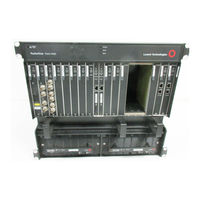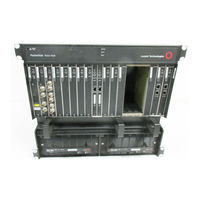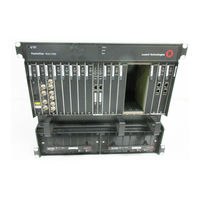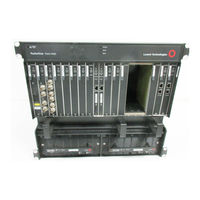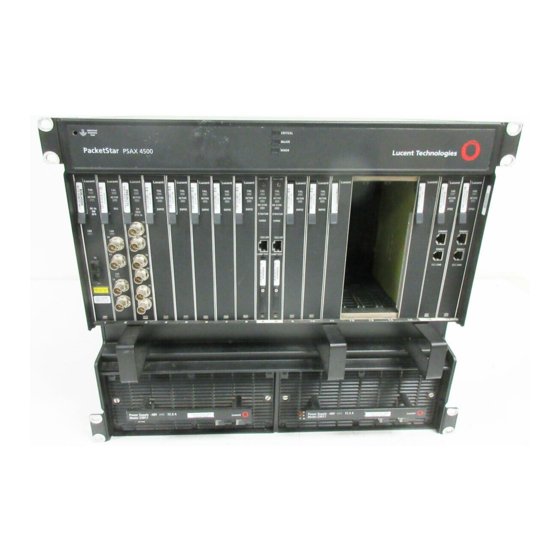
Lucent Technologies PacketStar PSAX 4500 Manuals
Manuals and User Guides for Lucent Technologies PacketStar PSAX 4500. We have 10 Lucent Technologies PacketStar PSAX 4500 manuals available for free PDF download: User Manual
Lucent Technologies PacketStar PSAX 4500 User Manual (722 pages)
Multiservice Media Gateway
Brand: Lucent Technologies
|
Category: Gateway
|
Size: 5 MB
Table of Contents
-
-
-
-
-
History47
-
-
-
-
Call States75
-
DS1 Service79
-
Dynamic CAC79
-
DS3 Service80
-
Overview80
-
Rate Options105
-
LANET Protocol106
-
Overview of OAM109
-
OAM Cell Fields110
-
OAM F4 Flows111
-
OAM F5 Flows111
-
OAM Hierarchy111
-
-
Channels121
-
Voice Processing126
-
Virtual Routing127
-
-
-
-
-
Diagnostics Menu162
-
-
Configuring PNNI
213 -
-
-
-
-
-
-
-
System460
-
ARP Status Codes512
-
IPT Result Codes545
-
Lim Status Codes549
-
PGT Result Codes568
-
PNNI Codes569
-
E PSAX Modules669
-
LIM 3–4 Module671
-
Alarm Module672
-
Ethernet Module690
-
Specifications704
-
Server Modules713
-
Advertisement
Lucent Technologies PacketStar PSAX 4500 User Manual (748 pages)
PSAX Multiservice Media Gateways
Brand: Lucent Technologies
|
Category: Gateway
|
Size: 10 MB
Table of Contents
-
-
-
Conventions42
-
-
Control Outputs102
-
-
-
System Features113
-
User Benefits113
-
-
Call States119
-
System121
-
User Interfaces121
-
DS1 Service123
-
DS3 Service123
-
Dynamic CAC123
-
Overview124
-
PNNI Hierarchies127
-
ATM Maintenance128
-
-
GR-303 Interface134
-
Interoperability136
-
-
-
PNNI Support143
-
OAM Cell Fields168
-
OAM F4 Flows170
-
OAM F5 Flows170
-
OAM Hierarchy170
-
-
UPC Support177
-
-
-
System194
-
System Security198
-
-
-
Diagnostics Menu251
-
-
-
Lucent Technologies PacketStar PSAX 4500 User Manual (644 pages)
1-Port Channelized STS-1e, T1 Format Module
Brand: Lucent Technologies
|
Category: Gateway
|
Size: 4 MB
Table of Contents
-
-
-
History20
-
-
-
-
Advertisement
Lucent Technologies PacketStar PSAX 4500 User Manual (596 pages)
PSAX 6-Port DS1 IMA Module
Brand: Lucent Technologies
|
Category: Gateway
|
Size: 4 MB
Table of Contents
-
-
-
-
History22
-
-
Lucent Technologies PacketStar PSAX 4500 User Manual (556 pages)
Multiservice Media Gateway
Brand: Lucent Technologies
|
Category: Gateway
|
Size: 4 MB
Table of Contents
-
-
-
-
CE-Marking11
-
-
-
-
History36
-
-
Lucent Technologies PacketStar PSAX 4500 User Manual (404 pages)
21-Port High-Density E1 Multiservice Module
Brand: Lucent Technologies
|
Category: Gateway
|
Size: 4 MB
Table of Contents
-
Contents
12 -
-
-
Conventions31
-
-
Lucent Technologies PacketStar PSAX 4500 User Manual (268 pages)
4-Port Voice 2-Wire Office Module for the PacketStar PSAX Multiservice Media Gateways
Brand: Lucent Technologies
|
Category: Telephone Accessories
|
Size: 1 MB
Table of Contents
Lucent Technologies PacketStar PSAX 4500 User Manual (156 pages)
for the PacketStar PSAX Multiservice
Brand: Lucent Technologies
|
Category: Control Unit
|
Size: 1 MB
Table of Contents
-
-
Notices3
-
-
Conventions23
-
Lucent Technologies PacketStar PSAX 4500 User Manual (194 pages)
DSP2x Voice Server Modules
Brand: Lucent Technologies
|
Category: Gateway
|
Size: 2 MB
Table of Contents
Lucent Technologies PacketStar PSAX 4500 User Manual (54 pages)
Alarm Module
Brand: Lucent Technologies
|
Category: Security System
|
Size: 0 MB
Table of Contents
-
-
-
-
History12
-
Conventions14
-
Advertisement
Related Products
- Lucent Technologies PacketStar PSAX 1250
- Lucent Technologies PacketStar PSAX 1000
- Lucent Technologies PacketStar PSAX 2300
- Lucent Technologies PacketStar PSAX 60
- Lucent Technologies PacketStar PSAX
- Lucent Technologies PacketStar PSAX Series
- Lucent Technologies PacketStar PSAX 20
- Lucent Technologies PortMaster OR-LS
- Lucent Technologies PARTNER Voice Messaging
- Lucent Technologies PacketStar

